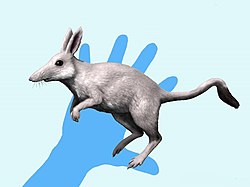Description
Currently, the family includes four genera, Eodelphis , Didelphodon , Fumodelphodon and Hoodootherium , which together include some seven different species. [1] [2] In addition, the Cenomanian species Pariadens kirklandi might be a member of the family. [2] Carneiro and Oliveira (2017) considered the species Eobrasilia coutoi from the early Eocene (Itaboraian) of Brazil to be a stagodontid; [4] if confirmed it would make it the only known Cenozoic and the only known South American member of the family. Stagodontids were some of the largest known Cretaceous mammals, ranging from 0.4 to 2.0 kilograms (0.88–4.41 lb) in mass. [5] One of the most unusual features of stagodontids are their robust, bulbous premolars, which are thought to have been used to crush freshwater mollusks, [6] a diet that apparently evolved independently at least twice within this clade. [7] Postcranial remains suggest that stagodontids may have been semi-aquatic. [8] [9] The most well described forms are found in Laramidia, but they are also present on Appalachian and South American sites, further leading credence to their aquatic habits. [10] Cretaceous fossils were also found in France, suggesting a pan-Laurasian distribution for Cretaceous metatherians. [3]
The evolution of Didelphodon and other large stagodontids (as well as large deltatheroideans like Nanocuris ) occurs after the local extinction of eutriconodont mammals, suggesting passive or direct ecological replacement. [11] They are considered rare in any given fauna they appear in, probably due to their specialised habits. [12]
This page is based on this
Wikipedia article Text is available under the
CC BY-SA 4.0 license; additional terms may apply.
Images, videos and audio are available under their respective licenses.





